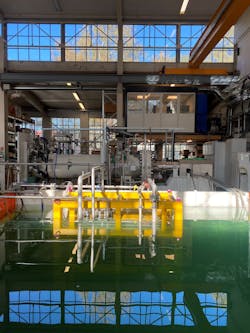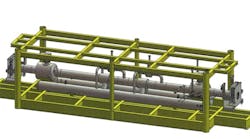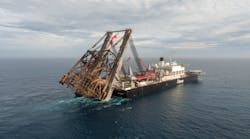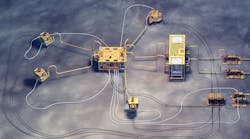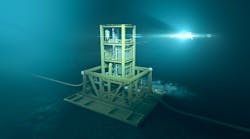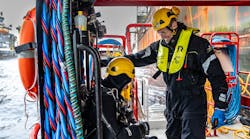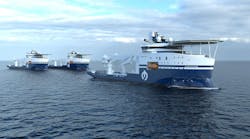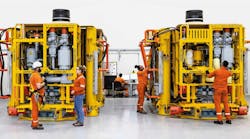Editor's note: This article first appeared in the March-April issue of Offshore magazine. Click here to view the full issue.
By Jeremy Beckman, Editor-Europe
Subsea pumps have been around for over two decades, with a track record of improving oil recovery. But take-up remains limited due largely to the high capex and running costs and associated system complexity.
A presentation at last September’s Multiphase Users Roundtable event in Houston by FASTsubsea and Petronas Research highlighted some of the drawbacks. Single-phase and multiphase (MPP) subsea pumps have sensitive mechanical seals, with the topside support equipment – including electric variable-speed drives and hydraulic power packs for clean barrier fluid supply – occupying extensive space that may not be available on the host FPSO or platform. The long hydraulic umbilicals between the platform and pumps increase the overall engineering and hardware cost and must undergo regular testing; and during operations, a failure of a subsea MPP pump typically requires deployment of an IMR vessel to retrieve the module, with associated production interruptions and lost revenue.
Aker Solutions and FSubsea in Norway are seeking to address these concerns with their independent (topside-less and seal-less) 2-MW subsea multiphase pumping system, FASTsubseaX. This is designed to be more autonomous than existing subsea pumps and to enable subsea boosting at fields where there is little or no available topside space. In addition, it is all-electric, with no hydraulic oils or chemicals, and is said to be less energy-intensive than some existing boosting systems, reducing CO2 emissions from production operations.
“FSubsea, meanwhile, had delivered more than 50 pumps for deepwater operations worldwide and had developed unique magnetic coupling technology and HydroMag, the drive line for the company’s own single-phase pumps. This is also the enabler for the `seal-less’ and `topside-less’ aspect of the FASTsubseaX MPP system: HydroMag eliminates the need for most conventional topside support equipment such as variable-speed drives, hydraulic umbilicals, mechanical seals and barrier-fluid systems. So for this development, capex costs could be up to 50% lower than conventional subsea pumping systems, and the environmental profile is improved due to the reduced CO2 footprint of the topside installation, operations and maintenance.”
Concept work started in late 2020 when Petronas decided to join the JIP and the co-venturers obtained funding from the Norwegian Research Council’s Demo2000 program. The work entered a more intensive phase in late 2022, when Equinor and Vår Energy also came onboard. Towards the end of this year, a full-scale FASTsubseaX MPP prototype is set for an extended trial at the multiphase testing loop in Tranby, to demonstrate TRL-4 technology readiness level. On completion next year, the development should be ready for a first commercial application offshore.
The cartridge, which took more than seven years to design, build and qualify to its current TR-5, API 17N status underwent several iterations to reach its current state of performance and reliability, and ensure a good fit with the HDU. “Scaling was done in two steps,” Fuglesangs explained, “first with the use of a simple prediction model that was developed and verified to test data in the qualification of the MultiBooster pump, and which enables mapping performance of new hydraulic sizes to a very high accuracy. Once that first stage was completed, a more detailed 3D CFD analysis followed of the selected hydraulics.”
As for the HDU, which should achieve TRL-4 (API 17N) readiness by mid-2023, the chief components are:
- A pressure-compensated, fixed-speed, 2-pole Ace electric motor
- A hydrodynamic torque converter made by Voith Turbo in Germany, based on the company’s established EL design
- A permanent magnetic coupling.
The HDU transfers rotational energy from the electric motor through a hermetically-sealed barrier to the pumping unit; it also converts fixed-speed rotational energy to variable-speed, which can result in a pump speed up to twice the motor speed. The hermetically-sealed barrier, located between the magnetic coupling driver and follower, separates the process media from the cleaning fluid and the surrounding atmosphere. That enables use of pressure-compensated motor technology, casings and electrical penetrators, with no requirement for a barrier fluid system.
According to Fuglesangs, the system is designed to respond to any changes in process conditions via the torque converter. “The electrical motor runs at a constant low speed, providing low vibrations and low viscous losses all while the pump operates at any desired speed (within the speed limits) without the need for an external variable-speed drive. This is achieved by the functionality of the torque converter in which a pump wheel mechanically connected to the motor output shaft transfers torque to a turbine shaft connected to the driver magnet in the magnetic coupling. Power is transferred hydrodynamically between the motor shaft and pump shaft.”
“To accommodate process changes during field life, the torque converter can be set to operate at constant guide vane position equals constant power transfer,” Fuglesang added. “This can be particularly advantageous in MPP applications for inherent and efficient management of gas slugs. A gas slug entering the pump will via its low density reduce the pump torque and the HDU will (inherently) `travel’ on the particular guide vane operating line by increasing the speed to maintain the power. This increase in speed is the exact desired action when experiencing a gas slug to efficiently evacuate the gas from the pump – which again, is automatically achieved in near real-time with the fixed guide vane operating mode (without any override of the control system). The motor will run at the supply frequency: the system is designed and tested with 50 and 60 Hz on the motor.”
FASTsubseaX’s liquid-filled, insulated, winding asynchronous motor is similar in design to the one applied for Equinor’s Tyrihans subsea raw water injection project (Tyrihans is a tieback to the Kristin semisubmersible platform). The magnetic coupling is based on patented FSubsea technology and rated to 345 bar and speeds up to 6,000 rpm, allowing the system to power pumps of up to 2 MW shaft power. “One of the main technical challenges is seen as the process lubricated bearings. However, we have been able to reduce this risk to a minimum with design, material selection and testing,” Fuglesangs said.
Tranby trials
At Tranby later this year, the performance test will cover the full speed, flow, and pressure range of the machine with particular focus on high pressure delivery at 70% GVF. Fuglesangs elaborated: “Furthermore, the plan is to perform the test with water and air with an option to also test with model oils and nitrogen. Water and air is a challenging multiphase fluid as the density ratio between liquid and gas can become very large. A large density ratio increases the tendency for phase separation and potential for gas locking. The purpose of including model oils and nitrogen (or air) is to map the performance under varying viscosities.”
“This is a full-scale prototype testing with an 8-stage back-to-back arranged pump cartridge. The pump unit (pump, motor and casings) weight and height is 30,000 kg and 8 m respectively. The pump unit will be placed in a subsea frame with additional elements, such as main piping and cooler. The design is targeting a longer service life than existing subsea pumping systems, which will be achieved mainly through the benefits of the HydroMag drive unit.”
According to Fuglesangs, the pump capacity competes with other conventional MPP systems up to 2MW pump shaft power. “The industry has progressively gone towards larger and larger systems with some manufacturers focusing on pumps up to 6MW. One advantage of the smaller FASTsubseaX is its suitability for distributed boosting, where the individual pumps can be located closer to the wells, potentially yielding a higher IOR. The distributed boosting potential of FASTsubsea X is further improved by the fact that one single power cable can supply power to several pumps while the pumps can operate at its desired, and unique, pump speed. This is achieved through the HydroMag drive unit’s built-in speed regulating device, the torque converter. Reliability is further enhanced by the elimination of the mechanical seal and its related sensitive barrier fluid system.”
In various brownfield or tie-back scenarios, he added, multiple FASTsubseaX pumps could be competitive with fewer traditional pumps, on a system lifecycle cost basis. “With the distributed boosting option, a `one-pump-per-tree’ approach is very lucrative with this technology as the power supply system remains very `slim.’ And since the pump does not require anything other than high and low voltage power and fibers for communication, this opens up competition for the cable scope – it could be any qualified subsea power cable make or brand.”
FASTsubsea has performed several in-depth assessments of step-out scenarios to determine the capability of the pump’s reach. “These analyses have looked at power from a stable grid, weather from a platform, FPSO or shore, but not yet from renewables. The conclusion is that 100+ km is possible with correct dimensioning of the power supply source and power distribution system.
“This technology can be deployed to tie-in wells to already developed fields, even those already supported by gas injection: however, the feasibility will depend on many aspects where the pump forms only a small, but important, part of the puzzle. The pumps can also, if considered early in the development, be a great alternative to gas injection in the first place with potential to greatly reduce cost related to drilling injection lines, injection pipelines, and topside equipment required for gas injection. However, the total IOR is complex and will obviously depend on the well performance.”
In Brazil’s presalt, Petrobras is deploying patented technology on the seafloor to reinject CO2 produced with the wellstream. Could FASTsubsea X be adapted accordingly? “This is a topic that we have not studied to a great detail,” Fuglesangs admitted. “When it comes to pumping dense-phase CO2, the approach will very much depend on the specific application. In some cases, it may make more sense to pump it, while in other cases, compressing it may be more appropriate. FASTsubsea X can be a contender but a deeper investigation is required. We have seen some applications where single-phase pumps have performed very well on CO2 boosting.”
“For all field scenarios, upstream/well connection arrangements would be similar to those for existing subsea pumps, although we believe the FASTsubsea X system is more forgiving in its response to gas slugs, due to its hydrodynamic, dampened and fast-response coupling system. The maintenance philosophy is based on predictive maintenance through condition monitoring, with in-situ maintenance performed by standard work class ROVs.”


